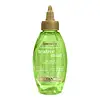What's inside
What's inside
 Key Ingredients
Key Ingredients

 Benefits
Benefits

 Concerns
Concerns

 Ingredients Side-by-side
Ingredients Side-by-side

Water
Skin ConditioningPolysorbate 20
EmulsifyingMelaleuca Alternifolia Leaf Oil
AntioxidantMentha Piperita Leaf Extract
Skin ConditioningHamamelis Virginiana Leaf Extract
Skin ConditioningMenthol
MaskingMenthyl Lactate
MaskingEthyltrimonium Chloride Methacrylate/Hydrolyzed Wheat Protein Copolymer
Polyquaternium-10
Cocamidopropyl Betaine
CleansingGlycerin
HumectantPropylene Glycol
HumectantSodium Hydroxide
BufferingCitric Acid
BufferingSodium Chloride
MaskingLactic Acid
BufferingPhenoxyethanol
PreservativeCaprylyl Glycol
EmollientParfum
MaskingWater, Polysorbate 20, Melaleuca Alternifolia Leaf Oil, Mentha Piperita Leaf Extract, Hamamelis Virginiana Leaf Extract, Menthol, Menthyl Lactate, Ethyltrimonium Chloride Methacrylate/Hydrolyzed Wheat Protein Copolymer, Polyquaternium-10, Cocamidopropyl Betaine, Glycerin, Propylene Glycol, Sodium Hydroxide, Citric Acid, Sodium Chloride, Lactic Acid, Phenoxyethanol, Caprylyl Glycol, Parfum
Glycine Soja Oil
EmollientMelaleuca Alternifolia Leaf Oil
AntioxidantCarthamus Tinctorius Seed Oil
MaskingRosa Canina Fruit Oil
EmollientPrunus Amygdalus Dulcis Oil
Skin ConditioningArachis Hypogaea Oil
Skin ConditioningBHT
AntioxidantAloe Barbadensis Leaf Extract
EmollientTocopherol
AntioxidantHelianthus Annuus Seed Oil
EmollientChamomilla Recutita Extract
Skin ConditioningArnica Montana Flower Extract
MaskingRosmarinus Officinalis Leaf Extract
AntimicrobialSalvia Officinalis Leaf Extract
CleansingPinus Palustris Leaf Extract
TonicArctium Minus Root Extract
Skin ConditioningCitrus Medica Limonum Peel
Skin ConditioningHedera Helix Extract
AntimicrobialCalendula Officinalis Flower Extract
MaskingTropaeolum Majus Extract
AntimicrobialLamium Album Flower Extract
AstringentIsopropyl Myristate
EmollientParfum
MaskingPhenoxyethanol
PreservativeMethylparaben
PreservativeIsopropylparaben
PreservativeIsobutylparaben
AntimicrobialButylparaben
MaskingCI 47000
Cosmetic ColorantGlycine Soja Oil, Melaleuca Alternifolia Leaf Oil, Carthamus Tinctorius Seed Oil, Rosa Canina Fruit Oil, Prunus Amygdalus Dulcis Oil, Arachis Hypogaea Oil, BHT, Aloe Barbadensis Leaf Extract, Tocopherol, Helianthus Annuus Seed Oil, Chamomilla Recutita Extract, Arnica Montana Flower Extract, Rosmarinus Officinalis Leaf Extract, Salvia Officinalis Leaf Extract, Pinus Palustris Leaf Extract, Arctium Minus Root Extract, Citrus Medica Limonum Peel, Hedera Helix Extract, Calendula Officinalis Flower Extract, Tropaeolum Majus Extract, Lamium Album Flower Extract, Isopropyl Myristate, Parfum, Phenoxyethanol, Methylparaben, Isopropylparaben, Isobutylparaben, Butylparaben, CI 47000
Alternatives
Ingredients Explained
These ingredients are found in both products.
Ingredients higher up in an ingredient list are typically present in a larger amount.
This tea tree oil comes from the leaves of the Tea Tree plant. Tea tree oil has antioxidant, anti-inflammatory, and antimicrobial properties.
According to the book Journal of Profiles of Drug Substances, tea tree helps in reducing acne-causing bacteria such as Propionibacterium acnes. This is due to the Terpinen components of tea tree oil.
Tea tree may cause sensitivity and irritation for some people. This oil naturally contains fragrance such as linalool and limonene.
However, research shows irritation usually occurs when using pure tea tree oil and not in cosmetic products.
Tea tree oil was found to help relieve the symptoms of psoriasis in one study.
Tea tree oil is toxic when ingested. Another study showed it to caused damage to the nervous system of dogs and cats when applied to their skin or given orally.
Learn more about Melaleuca Alternifolia Leaf OilParfum is a catch-all term for an ingredient or more that is used to give a scent to products.
Also called "fragrance", this ingredient can be a blend of hundreds of chemicals or plant oils. This means every product with "fragrance" or "parfum" in the ingredients list is a different mixture.
For instance, Habanolide is a proprietary trade name for a specific aroma chemical. When used as a fragrance ingredient in cosmetics, most aroma chemicals fall under the broad labeling category of “FRAGRANCE” or “PARFUM” according to EU and US regulations.
The term 'parfum' or 'fragrance' is not regulated in many countries. In many cases, it is up to the brand to define this term.
For instance, many brands choose to label themselves as "fragrance-free" because they are not using synthetic fragrances. However, their products may still contain ingredients such as essential oils that are considered a fragrance by INCI standards.
One example is Calendula flower extract. Calendula is an essential oil that still imparts a scent or 'fragrance'.
Depending on the blend, the ingredients in the mixture can cause allergies and sensitivities on the skin. Some ingredients that are known EU allergens include linalool and citronellol.
Parfum can also be used to mask or cover an unpleasant scent.
The bottom line is: not all fragrances/parfum/ingredients are created equally. If you are worried about fragrances, we recommend taking a closer look at an ingredient. And of course, we always recommend speaking with a professional.
Learn more about ParfumPhenoxyethanol is a preservative that has germicide, antimicrobial, and aromatic properties. Studies show that phenoxyethanol can prevent microbial growth. By itself, it has a scent that is similar to that of a rose.
It's often used in formulations along with Caprylyl Glycol to preserve the shelf life of products.